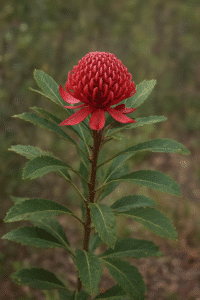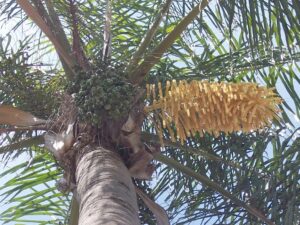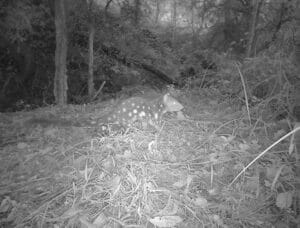Coastal Morning Glory, Ipomoea cairica, is an evil cousin of the much-loved Sweet Potato, Ipomoea batata. A native of tropical Asia and Africa, it wasted no time escaping gardens after being introduced to Australia as an ornamental for its pretty purple to pink flowers. Long runners that can form roots at the nodes allow rapid vegetative propagation, and seeds are readily spread by water, making it a common curse of riparian areas. Tolerant of a wide variety of soils and conditions, from coastal dunes and estuarine riversides and swamps to freshwater riparian areas, rainforest and woodland, this plant is one of the worst and most widespread Ecosystem Transformer weeds in the MidCoast area. This is a weed capable of smothering all layers of vegetation, including high into the canopy, threatening large trees.
As the days get longer and we head into Spring after a wet Winter, Morning Glory is growing ridiculously quickly – its other common name, “Mile a Minute”, is very apt.
When managing Morning Glory, remember as with any weed threat to prioritise new infestations, outliers, and your most resilient bush areas (with intact canopy and diverse vegetation) before putting time and effort into well established vine thickets in highly disturbed areas. Follow-up is vital to successful treatment, so be careful that the amount of primary work does not exceed your capacity to follow up.
Seedlings and small plants can be carefully hand pulled or dug out, especially on sandy soils, but Morning Glory rapidly develops deep taproots that are easily broken. The treatment method of choice is usually Stem Scrape herbicide application – neat waterway-safe Glyphosate 360 with a little dye in water in a dripper applicator is applied to a fresh, shallow scrape of the stem, just deep enough to expose the green cambium layer. Use a sharp-edged tool like a knife, Hori Hori or secateurs, go gently to avoid breaking off the stem. How long to stem scrape? You will commonly see “15-30cm” advised, which is fine for a dose near the base of a small plant that has no other ground connection, but for very long vines, especially if the base has not been found, a full arms-length stem scrape of a metre or so is the go. Apply herbicide promptly after making the scrape.
Where vines are climbing up into shrubs and trees, they can be “skirted” – cut so that the vine in the canopy has no connection to the ground. This method helps to thoroughly remove weed vine from the canopy. To avoid leaving low-dangling dead vines that can be a trellis for future vine regrowth from below, gently pull down on vines going up into the canopy (be very careful not to use force, which can cause vine-laden branches to snap!) and cut as high as you comfortably can. Then gently pull on the ground side of the vine until it is tight, and give it a nice long stem scrape as low to the ground as you can reach, and if possible, follow it to the vine’s base, stem scraping close to the roots and stem scraping any other runners emanating from the same base. Secateurs are handy for this work, as the blade can be used for stem scraping, while the cutting action is good for cutting vines out of trees, and for pruning low-hanging branches to reduce reinfestation of shrubs and trees by vine.
[Do not use skirting for vines with aerial tubers like Madeira Vine – to give the best chance of killing aerial tubers, leave Madeira Vine intact and carefully, gently stem scrape for as long as you can reach]
Follow up stem scrape work after about 3 weeks, targeting any green leaves that remain, aiming where possible to identify and treat the base of the plant.
Article by Joël Dunn, July 2025




